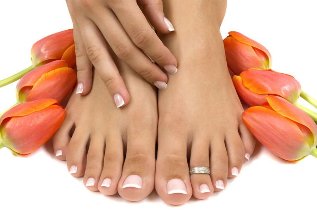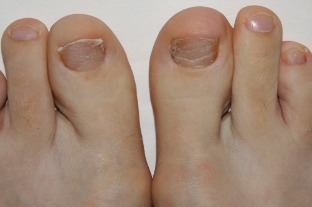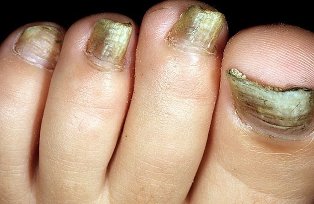Many do not realize that banal sweating of the feet, accompanied by an unpleasant odor, suffers more than half of the population of our planet, — one of the main symptoms of nail fungus. This disease is a risk to be ill, who's been a little neglected personal Hygiene. Nail fungus is lurking everywhere, especially in public areas. And the worst thing is that nail fungus is enough insidious disease: to cases, its treatment is a long and not always successful, since athlete's foot tends to return. In order to detect the disease in time and begin the treatment, you should know all of the signs of the fungus on the legs.

How common is the disease?
The infection can cause parasitic fungi. The ideal environment for their reproduction and development — increased humidity in combination with warm atmosphere. It is believed that the most important places where high risk of Contracting nail fungus, it baths, saunas, water parks, swimming pools, nail salons, etc. statistics, However, completely refutes this assertion: nail fungus can start, the home about the things shared use (towels, shoes, clothes, carpets, shower or bathtub), if someone in the family has this Problem, or at a Party, for example, by means of Slippers, kindly offered by a host (though he may not be aware of the presence of his disease).
But what are the factors that affect the development of fungal disease? You will notice such basic moments, lead to infection onychomycosis:
- Lowering of immunity;
- Injuries of the nail plate;
- Blood circulation disorders in the lower extremities, of what can happen when wearing tight shoes;
- Pathology stop of the anatomical character;
- Obesity;
- Diabetes mellitus;
- increased sweating.
In order to protect, at least partially, even, exclusively use their stuff thoroughly antiseptics tub and shower handle, to clean a towel of your own and regularly wash carpets, decontaminated shoes. And you miss are not effective for the treatment of athlete's foot the Moment (because everyone knows that the treatment will be most effective in the early stages of the development of the disease), you have the first signs of nail fungus on the feet.
How to recognize onychomycosis?
Signs of nail fungus in the different phases can vary, what is the continued progression of the infection. For example, on the first (early) Phase of any symptoms are practically non-existent. On to the nail plate, you can see, barely visible white spots or stripes. Such symptoms should alert you, because you have to be a fungal infection, talk about the present. If you ignore the first signs of the disease, the risk of Pilz, the exceptionally healthy nails run, and it leads to the formation of pus in the periungual tissues, and gangrene and Amputation of the lower extremities threatens.
The second stage of the fungal disease of the nails is manifested in a lack of natural Shine of the nail plate. More finger nail changes color: yellow, white and brown stripes. Deformation of the upper and lateral part of the nail sections. To see these symptoms well in the photo.
Started the stage of onychomycosis is characterized by fragility and layering of the nail plate, inflammation of the nail skin. There is the risk of loss of the nail is. But the most annoying thing is that the disease continues to spread to other nails of the lower extremities, but also on the skin of the feet. The treatment in this case should start immediately in order to avoid the unpleasant consequences of the disease.

The second and third stage of onychomycosis, can the Patient himself: the nail gets yellow or dirty-brown color, it is doughy and thick, behind the nail bed, it becomes very brittle and fragile. Sometimes the wearing of closed shoes is) painful and itching of the skin — unbearable (this Symptom is specially reinforced in case of excessive sweating. In addition, cases of suspected onychomycosis can be manifested to the following accompanying symptoms on the skin close to the nails:
- burn;
- intolerant itching;
- Flaking and dryness;
- Inflammation;
- Oozing Lesions;
- Thickening and cornification disorders.
By providing us with the first signs of nail fungus, you should immediately consult a specialist who will prescribe the optimal form of treatment.
What are the different types of onychomycosis are?
Determine the 3 types of onychomycosis, manifested their characteristics.
- Normotroficheskie nail fungus by a change in the color of the nail plate of the diseased nail can be shades of white to dark green. In the first Phase of the disease on the nail white spots or longitudinal appear spacious. With progression of the disease coloring of the nail of progression can vary, and the fungus spreads to the entire area of the nail plate. However, the thickness is not changed, and the natural sheen is maintained.
- Hypertrophic nail fungus is the change in the color of the nail plate, loss of luster of the surface, marked thickening and deformation. Nails strongly exfoliate, begins its partial destruction.
- Atrophic fungus by changing the color of the nail to the next thinning. The result of this is a fungal infection of the rejection of the diseased nail or an infected Phase.
Determine the presence of mold on the nails you can, but an accurate diagnosis can only be a specialist. To do this, you must come to the clinic, on the analysis of the scraping of the diseased nail or skin, to make of him. In addition to skin doctor will prescribe microscopic examination.
Signs of fungus the causative agent of the disease
The success of the treatment of nail fungus depends on how well the pathogen of the disease is diagnosed. The reason for this is that the disease is caused by a type of fungi, but several, and each of them sensitive to certain drugs. That is, if a variety is mildew die is resistant to a particular drug, then a different pathogen from that medium.

Common nail fungus cause:
- Yeast;
- Dermatophytes;
- Mold.
If the cause of nail yeast and become a fungus, the disease reveal an almost unreal. Signs of mildew on the nails of the feet in this case are the following (they can manifest later on a long time): desquamation of the nail plate, and a slight itching of the skin next to the nail (itching may be absent). The infection of the nails yeast occurs in 4-4,5% of the cases.
Dermatophytes nails to beat people a lot more frequently than the previous pathogen 94.5% of all cases is infection of the nails by a fungus. Dermatophytes are manifested in three types, the infection of each of them in different ways:
- For the first type is characterised by a comprehensive defeat of the feet, toes and nails. The fungus spreads easily on the skin and nails of the hands.
- The second type relates only to the nail of the little finger or the big toe. Distributed on the inter-digital folds, and how all the fingers, and some.
- The third type are not affected by the inclusion of the nails of the thumb and the little finger, but the skin of the mushroom.
The last type of fungal mold. His Pathogens — Fungi. The disease occurs only in 1% of cases. A mushroom of this type more common in HIV-infected people.
Other symptoms of a fungal infection of the nails
To lack often the beginning of the disease distinct signs of fungal infection of the nails. But if you are attentive, you may notice that some of the changes in the structure of the nail and its look. As already mentioned, on the nail plate, longitudinal to appear or round white spots, the nail may be lost with a curve, its smoothness and Shine. Progresses, the disease will be more and more of the nail plate is destroyed: first, its hue changes, then the surface of the nail is layered is scaly, it is thickened or thin, breaks. The color of the nail depends on the type of fungus was the causative agent of the infection.
In addition to the basic functions of onychomycosis, there are others:

- the fragility of the edges of the nail plate or the entire surface;
- Distortion of the shapes of the nail, the change of its structure;
- Blackening of the nail;
- the cutting of the nails under the skin;
- Goiter, Drowsiness, General Weakness;
- Detachment of the plate from the nail bed, which leads to the formation of Plaque under the nail, white or yellow shade with the unpleasant odor;
- the itching, cracking, burning of the skin in the immediate vicinity of the affected nail;
- Goiter, Drowsiness, General Weakness.
Any deviation in the outer shape of the toenails should be warned, because it will talk about the development of nail fungus could. The first action in this case — a hike to a skin doctor who will confirm or refute your fears. If you do not do this immediately, the disease will progress. At first glance, nothing wrong with this disease. However, apart from purely aesthetic issues and complaints, the fungus to serious complications, up to and purulent infection of the affected areas, and even the development of gangrene. can Therefore, do not hesitate with treatment, to take measures immediately, as the disease was discovered.































